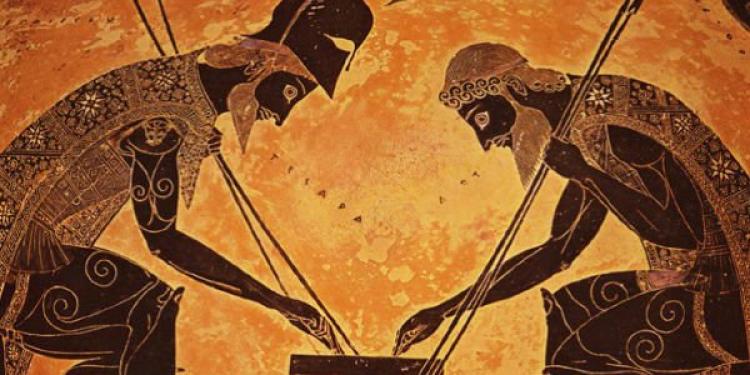Gambling in ancient Greece: the origin of gambling games in Europe (part 1)
Posted: April 4, 2017
Updated: October 6, 2017

Sources reporting on gambling in ancient Greece present the roots of gambling practices in Western Europe
In the history of mankind entertainment has always played an important role, and one of the most common ways of entertainment that people enjoyed, was without any doubt: gambling! Anthropological sources show that through different epochs and different geographical regions, gambling games remained a crucial part of the culture of different communities. This statement comes from the fact that gambling in the form of guessing and predicting an outcome, was closely connected to religious practices and rituals.
Ancient Greece is the first place where we find evidence of gambling games at European soil dating back to the 7th century B.C, report gambling news. As Encyclopedia Britannica stresses it was the Minoan civilization that is believed to be the one that first introduced games very similar to today’s poker, while gambling around animals and human contests was popular all over ancient Greece.
They were also used, as online gambling sites in the UK mention, as a means to predict the future and to provide divination. Depending on the side with which the knuckle-bone landed on the ground, special names of the throws, four in number, were given and each side and for each side certain amount of points were given. The winner in the game was the one with higher number of points in the end.In Greek literature, the astragalis or cubic knuckle-bones are first mention by Homer, but no explicit rules of the games played with them is described.
In Ancient Greece one of the most popular dice games was Tesserae, but the board games, as online gambling sites in EU stress, were much more widely played among the ordinary people. Both Plato and Homer mention board game called 'petteia' which was played on boards of varying sizes with black and white stones initially lined up on opposite sides.

In a book called Onomasticon by the Greek writer Pollux, he describes Petteia in the following way: ”the game is played with many pieces on a board with spaces disposed among lines: the board is called the 'city' (polis) and each piece is called a 'dog'; the pieces are of two colors, and the art of the game consists in capturing pieces of one color by enclosing them between two of the other color.” Petteia as a game became so popular in ancient Greece that later sources claim that the term ”petteia” became generic for all sorts of board games in Ancient Greece.
In the history of mankind entertainment has always played an important role, and one of the most common ways of entertainment that people enjoyed, was without any doubt: gambling! Anthropological sources show that through different epochs and different geographical regions, gambling games remained a crucial part of the culture of different communities. This statement comes from the fact that gambling in the form of guessing and predicting an outcome, was closely connected to religious practices and rituals.
Ancient Greece is the first place where we find evidence of gambling games at European soil dating back to the 7th century B.C, report gambling news. As Encyclopedia Britannica stresses it was the Minoan civilization that is believed to be the one that first introduced games very similar to today’s poker, while gambling around animals and human contests was popular all over ancient Greece.
Games that ancient Greeks played: from “odds and evens” to the use of astragalis
It is commonly hold that gambling games in Ancient Greece fall in three categories. The most widespread ones among the ordinary people were those in which one has to guess the odd or even number of certain objects that are thrown. Other similar games include tossing two-colored shells and trying to predict the results (whether it is “night” or “day”)Games with dices were introduced later in the cultural life of the ancient Greeks. The first dices found in Greece are believed come from the 7th century B.C. But before the use of dices it was common for ancient cultures, especially around the Mediterranean, to use “astragalis” for the later dice games. The astragalis ( Greek: “αστράγαλοι” ) were small cubic knucklebones, used originally for playing the game astragalismos (Greek:“αστραγαλισμός”) as well as games of chance.
• Gambling in Ancient Greece was also entertainment of the Gods
• The first dices in ancient Greece date back to the 7th century
• Games with astragalis are considered to be predecessors of the dice and board
They were also used, as online gambling sites in the UK mention, as a means to predict the future and to provide divination. Depending on the side with which the knuckle-bone landed on the ground, special names of the throws, four in number, were given and each side and for each side certain amount of points were given. The winner in the game was the one with higher number of points in the end.In Greek literature, the astragalis or cubic knuckle-bones are first mention by Homer, but no explicit rules of the games played with them is described.
The appearance of dice and board games in Ancient Greece
The appearance of the dices in Ancient Greece brought with it two types of dice games: one that included boards and others that only used the dices. Most of the games of the ancient Greeks usually used three or four dice which were thrown after being shaken in a special cup. From the depictions and reliefs on many ancient architectural localities remaining today in Greece we see that dice games were common for man as well as for women. The most famous artwork related to dices is the vase painted by Exekias which portrays Greek heroes Ajax and Achilles playing dice during the Trojan War.In Ancient Greece one of the most popular dice games was Tesserae, but the board games, as online gambling sites in EU stress, were much more widely played among the ordinary people. Both Plato and Homer mention board game called 'petteia' which was played on boards of varying sizes with black and white stones initially lined up on opposite sides.

Ancient Greek astragali used for playing gambling games
In a book called Onomasticon by the Greek writer Pollux, he describes Petteia in the following way: ”the game is played with many pieces on a board with spaces disposed among lines: the board is called the 'city' (polis) and each piece is called a 'dog'; the pieces are of two colors, and the art of the game consists in capturing pieces of one color by enclosing them between two of the other color.” Petteia as a game became so popular in ancient Greece that later sources claim that the term ”petteia” became generic for all sorts of board games in Ancient Greece.
Related content
Subscribe
0 Comments












